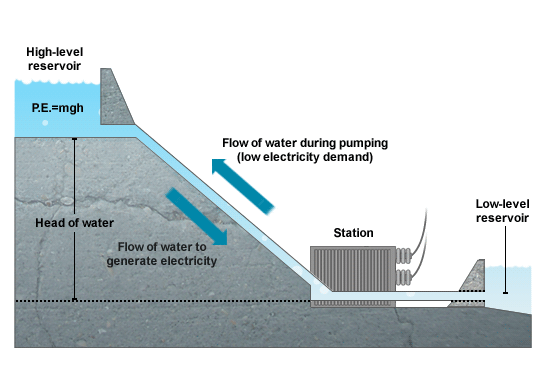Pumped Hydroelectric Energy Storage
The current benchmark for large-scale energy storage.

Figure 1: Schematic of a PHES system.
This is by far the most satisfactory currently available method of bulk energy storage, and thus is the benchmark for any large-scale energy storage system. A pumped storage system requires two water reservoirs – an upper and a lower – and water is moved between these two levels. By using surplus (or cheap) electricity to pump water from the lower reservoir to the upper reservoir, energy can be stored in the form of gravitational potential energy, which can then be converted back into electrical energy at a later time by allowing the water to flow back down from the upper to lower reservoir though a turbine and generator – just like conventional hydroelectric technology. In this manner energy is converted from electrical to kinetic to gravitational potential and then back to kinetic and finally back to electrical again.
The round trip efficiency of this process is dependent on pump, motor, turbine and generator efficiencies as well as evaporation rates. It is not unusual for these plants to expect a 70 – 85% round trip efficiency. Pumped storage plants are relatively common worldwide, with four in the UK. The major drawback to pumped hydroelectric storage is the necessity for favourable geography; both a lower and a higher reservoir are required as well as favourable terrain between them. The storage capacity depends on size of the reservoirs and the power on the flow and head of the water. The energy density is proportional to the height (head) between the two reservoirs so it will usually only become viable to make a PHS facility if a certain head is available between the two reservoirs. There is a natural connection between head and flow-rate. If head can be increased then flow-rate can be reduced for the same output and correspondingly, if flow-rate can be increased then head can be reduced for the same power. Due to the necessity for favourable geography, the best PHS sites in the UK have been implemented. To increase the potential for PHS this limitation must be relaxed. Investigations into Underground PHS (U-PHS) and seawater PHS schemes are underway, and if they prove commercially viable widespread implementation can be expected. Currently only one 30MW Seawater PHS scheme exists in Japan.
Interestingly, despite its continued operation in many different electricity systems, recent work has highlighted that PHS has historically only been commissioned under the remit of publicly owned vertically integrated utilities in monopoly markets. Read more
PHS Performance Characteristics and Applications
Pumped Hydro Storage is at present the only utilised method of large-scale grid energy storage. It comprises 3% of global installed power capacity installed and 97% of global installed electrical energy storage. PHS has a time response from a few seconds to a few minutes, a large scale output and storage capacity with hourly to daily output durations. It can be used to provide substantial benefits to the energy system including frequency control, ramping/load levelling and peak shaving, load following, and provision of stand by reserve. Due to the low energy density of pumped storage schemes they are really only applicable for large scale grid applications.
Summary of characteristics
| Typical Capacity | Typical Power | Efficiency (%) | Storage Duration | $/kWh | $/kW | Lifespan | Cycling capacity |
| 0.5 – 20 GWh | 50MW – 3GW | 75-85 [1,2] | Hours - days | 14 – 28 [2], 5 – 100 [3],250 - 430 [4] | 600-2000 [3], 1500-4300 [4] | 50 years | High |
It must be noted that the pumped hydro costs are incredibly site specific. The EPRI report [4] cost estimates include costs for substation, interconnection and contingency.
References
[4] EPRI, 2010. Electricity Energy Storage Technology Options, ;